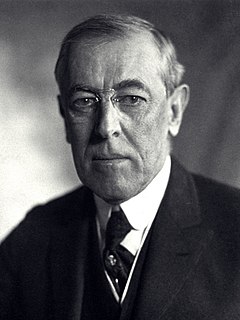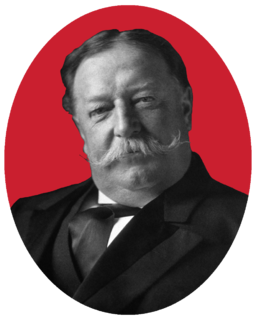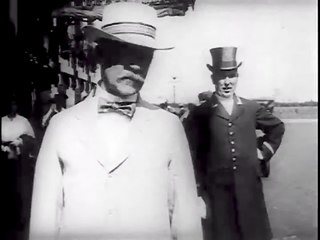
Thomas Woodrow Wilson was an American politician and academic who served as the 28th president of the United States from 1913 to 1921. A member of the Democratic Party,Wilson served as the president of Princeton University and as the governor of New Jersey before winning the 1912 presidential election. As president,Wilson changed the nation's economic policies and led the United States into World War I in 1917. He was the leading architect of the League of Nations,and his progressive stance on foreign policy came to be known as Wilsonianism.

The 1912 United States presidential election was the 32nd quadrennial presidential election,held on Tuesday,November 5,1912. Democratic Governor Woodrow Wilson unseated incumbent Republican President William Howard Taft and defeated former President Theodore Roosevelt,who ran under the banner of the new Progressive or "Bull Moose" Party. This is the most recent presidential election in which the second-place candidate was neither a Democrat nor a Republican. This also remains the most recent election where a former president ran after leaving office. This is the most recent election to date in which four candidates received over 5 percent of the vote.

The 1916 United States presidential election was the 33rd quadrennial presidential election,held on Tuesday,November 7,1916. Incumbent Democratic President Woodrow Wilson narrowly defeated former Associate Justice of the Supreme Court Charles Evans Hughes,the Republican candidate.

The 1920 United States presidential election was the 34th quadrennial presidential election,held on Tuesday,November 2,1920. In the first election held after the end of World War I and the first election after the ratification of the Nineteenth Amendment,Republican Senator Warren G. Harding of Ohio defeated Democratic Governor James M. Cox of Ohio.

Charles Warren Fairbanks was an American politician who served as a senator from Indiana from 1897 to 1905 and the 26th vice president of the United States from 1905 to 1909. He was also the Republican vice presidential nominee in the 1916 presidential election. Had the Republican ticket been elected,Fairbanks would have become the third vice president to multiple presidents,after George Clinton and John C. Calhoun.

Robert Marion "Fighting Bob" La Follette Sr.,was an American lawyer and politician. He represented Wisconsin in both chambers of Congress and served as the 20th Governor of Wisconsin. A Republican for most of his life,he ran for president of the United States as the nominee of his own Progressive Party in the 1924 presidential election. Historian John D. Buenker describes La Follette as "the most celebrated figure in Wisconsin history".

Albert Baird Cummins was an American lawyer and politician. He was the 18th governor of Iowa elected to three consecutive terms and U.S. senator for Iowa serving for 18 years.

The New Freedom was Woodrow Wilson's campaign platform in the 1912 presidential election,and also refers to the progressive programs enacted by Wilson during his first term as president from 1913 to 1916 while the Democrats controlled Congress. First expressed in his campaign speeches and promises,Wilson later wrote a 1913 book of the same name. In terms of legislation,wartime policies are generally not considered part of the New Freedom. After the 1918 midterm elections,Republicans took control of Congress and were mostly hostile to the New Freedom. As president,Wilson focused on three types of reform:
- Tariff reform:This came through the passage of the Underwood Tariff Act of 1913,which lowered tariffs for the first time since 1857 and went against the protectionist lobby.
- Business reform:This was established through the passage of the Federal Trade Commission Act of 1914,which established the Federal Trade Commission to investigate and halt unfair and illegal business practices by issuing "cease and desist" orders,and the Clayton Antitrust Act.
- Banking reform:This came in 1913 through the creation of the Federal Reserve System and in 1916 through the passage of the Federal Farm Loan Act,which set up Farm Loan Banks to support farmers.

The 1912 Republican National Convention was held at the Chicago Coliseum,Chicago,Illinois,from June 18 to June 22,1912. The party nominated President William H. Taft and Vice President James S. Sherman for re-election for the 1912 United States presidential election.

The Progressive Party was a third party in the United States formed in 1912 by former president Theodore Roosevelt after he lost the presidential nomination of the Republican Party to his former protégérival,incumbent president William Howard Taft. The new party was known for taking advanced positions on progressive reforms and attracting leading national reformers. After the party's defeat in the 1912 presidential election,it went into rapid decline in elections until 1918,disappearing by 1920. The Progressive Party was popularly nicknamed the "Bull Moose Party" when Roosevelt boasted that he felt "strong as a bull moose" after losing the Republican nomination in June 1912 at the Chicago convention.

Woodrow Wilson's tenure as the 28th president of the United States,lasted from March 4,1913,until March 4,1921. Wilson,a Democrat who previously served as the governor of New Jersey,became president after winning the 1912 election,gaining a large majority in the electoral vote and a 42% plurality of the popular vote in a four-candidate field. Wilson was re-elected in 1916,defeating Republican candidate Charles Evans Hughes by a narrow margin. Despite his New Jersey base,most people thought of him as a Southerner,making him the first Southerner in the White House since Andrew Johnson in 1869,and just the second Democrat to be elected president since 1860.

The 1916 Republican National Convention was held in Chicago from June 7 to June 10. A major goal of the party's bosses at the convention was to heal the bitter split within the party that had occurred in the 1912 presidential campaign. In that year,Theodore Roosevelt bolted the GOP and formed his own political party,the Progressive Party,which contained most of the GOP's liberals. William Howard Taft,the incumbent president,won the nomination of the regular Republican Party. This split in the GOP ranks divided the Republican vote and led to the election of Democrat Woodrow Wilson. Although several candidates were openly competing for the 1916 nomination—most prominently conservative Senator Elihu Root of New York,Senator John W. Weeks of Massachusetts,and liberal Senator Albert Cummins of Iowa—the party's bosses wanted a moderate who would be acceptable to all factions of the party. They turned to Supreme Court Justice Charles Evans Hughes,who had served on the court since 1910 and thus had the advantage of not having publicly spoken about political issues in six years. Although he had not sought the nomination,Hughes made it known that he would not turn it down;he won the presidential nomination on the third ballot. Former Vice President Charles W. Fairbanks was nominated as his running mate. Hughes is the only Supreme Court Justice to be nominated for president by a major political party. Fairbanks is the last former vice president,to be nominated for vice president.

Vivian M. Lewis was an American jurist and politician. He was the Republican nominee for Governor of New Jersey in 1910 against Woodrow Wilson and lost the election.

The 1916 United States presidential election in New York took place on November 7,1916. All contemporary 48 states were part of the 1916 United States presidential election. Voters chose 45 electors to the Electoral College,which selected the president and vice president.

The 1912 United States presidential election in New York took place on November 5,1912. All contemporary 48 states were part of the 1912 United States presidential election. Voters chose 45 electors to the Electoral College,which selected the president and vice president.

The 1912 United States presidential election in New Jersey took place on November 5,1912. All contemporary 48 states were part of the 1912 United States presidential election. Voters chose 14 electors to the Electoral College,which selected the president and vice president.

The 1916 United States presidential election in Wisconsin was held on November 7,1916 as part of the 1916 United States presidential election. State voters chose 13 electors to the Electoral College,who voted for president and vice president.

The 1932 United States presidential election in Wisconsin was held on November 8,1932 as part of the 1932 United States presidential election. State voters chose 12 electors to the Electoral College,who voted for president and vice president.

The 1912 United States presidential election in South Dakota took place on November 5,1912,as part of the 1912 United States presidential election. Voters chose five representatives,or electors,to the Electoral College,who voted for president and vice president.

The 1912 United States presidential election in Missouri took place on November 5,1912,as part of the 1912 United States presidential election. Voters chose 18 representatives,or electors,to the Electoral College,who voted for president and vice president.
















